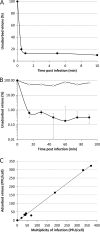First insights into the entry process of hyperthermophilic archaeal viruses
- PMID: 24089554
- PMCID: PMC3838266
- DOI: 10.1128/JVI.02742-13
First insights into the entry process of hyperthermophilic archaeal viruses
Abstract
A decisive step in a virus infection cycle is the recognition of a specific receptor present on the host cell surface, subsequently leading to the delivery of the viral genome into the cell interior. Until now, the early stages of infection have not been thoroughly investigated for any virus infecting hyperthermophilic archaea. Here, we present the first study focusing on the primary interactions between the archaeal rod-shaped virus Sulfolobus islandicus rod-shaped virus 2 (SIRV2) (family Rudiviridae) and its hyperthermoacidophilic host, S. islandicus. We show that SIRV2 adsorption is very rapid, with the majority of virions being irreversibly bound to the host cell within 1 min. We utilized transmission electron microscopy and whole-cell electron cryotomography to demonstrate that SIRV2 virions specifically recognize the tips of pilus-like filaments, which are highly abundant on the host cell surface. Following the initial binding, the viral particles are found attached to the sides of the filaments, suggesting a movement along these appendages toward the cell surface. Finally, we also show that SIRV2 establishes superinfection exclusion, a phenomenon not previously described for archaeal viruses.
Figures





Similar articles
-
Virology. A virus that infects a hyperthermophile encapsidates A-form DNA.Science. 2015 May 22;348(6237):914-7. doi: 10.1126/science.aaa4181. Science. 2015. PMID: 25999507 Free PMC article.
-
DNA-Interacting Characteristics of the Archaeal Rudiviral Protein SIRV2_Gp1.Viruses. 2017 Jul 18;9(7):190. doi: 10.3390/v9070190. Viruses. 2017. PMID: 28718834 Free PMC article.
-
Protein-protein interactions leading to recruitment of the host DNA sliding clamp by the hyperthermophilic Sulfolobus islandicus rod-shaped virus 2.J Virol. 2014 Jun;88(12):7105-8. doi: 10.1128/JVI.00636-14. Epub 2014 Apr 2. J Virol. 2014. PMID: 24696494 Free PMC article.
-
Genomics and biology of Rudiviruses, a model for the study of virus-host interactions in Archaea.Biochem Soc Trans. 2013 Feb 1;41(1):443-50. doi: 10.1042/BST20120313. Biochem Soc Trans. 2013. PMID: 23356326 Free PMC article. Review.
-
Exceptional virion release mechanism: one more surprise from archaeal viruses.Curr Opin Microbiol. 2011 Jun;14(3):315-20. doi: 10.1016/j.mib.2011.04.006. Epub 2011 Apr 30. Curr Opin Microbiol. 2011. PMID: 21531608 Review.
Cited by
-
The structures of two archaeal type IV pili illuminate evolutionary relationships.Nat Commun. 2020 Jul 9;11(1):3424. doi: 10.1038/s41467-020-17268-4. Nat Commun. 2020. PMID: 32647180 Free PMC article.
-
Virology. A virus that infects a hyperthermophile encapsidates A-form DNA.Science. 2015 May 22;348(6237):914-7. doi: 10.1126/science.aaa4181. Science. 2015. PMID: 25999507 Free PMC article.
-
An extensively glycosylated archaeal pilus survives extreme conditions.Nat Microbiol. 2019 Aug;4(8):1401-1410. doi: 10.1038/s41564-019-0458-x. Epub 2019 May 20. Nat Microbiol. 2019. PMID: 31110358 Free PMC article.
-
Archaeal Viruses from High-Temperature Environments.Genes (Basel). 2018 Feb 27;9(3):128. doi: 10.3390/genes9030128. Genes (Basel). 2018. PMID: 29495485 Free PMC article. Review.
-
ORF4 of the Temperate Archaeal Virus SNJ1 Governs the Lysis-Lysogeny Switch and Superinfection Immunity.J Virol. 2020 Jul 30;94(16):e00841-20. doi: 10.1128/JVI.00841-20. Print 2020 Jul 30. J Virol. 2020. PMID: 32522850 Free PMC article.
References
-
- Krupovic M, White MF, Forterre P, Prangishvili D. 2012. Postcards from the edge: structural genomics of archaeal viruses. Adv. Virus Res. 82:33–62 - PubMed
-
- Pina M, Bize A, Forterre P, Prangishvili D. 2011. The archeoviruses. FEMS Microbiol. Rev. 35:1035–1054 - PubMed
-
- Prangishvili D. 2013. The wonderful world of archaeal viruses. Annu. Rev. Microbiol. 67:565–585 - PubMed
-
- Prangishvili D, Garrett RA, Koonin EV. 2006. Evolutionary genomics of archaeal viruses: unique viral genomes in the third domain of life. Virus Res. 117:52–67 - PubMed
Publication types
MeSH terms
LinkOut - more resources
Full Text Sources
Other Literature Sources

